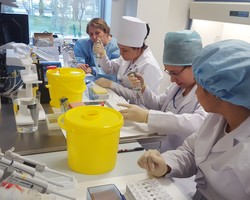Time for integrated and people-centred services for HIV, TB and viral hepatitis

WHO
The international medical journal, The Lancet, has published an article demonstrating the benefits of integrated and people-centred services in responding to the rise of HIV, tuberculosis (TB) and viral hepatitis in eastern European and central Asian countries of the WHO European Region.
Ensuring timely detection to save life
“In our Region,” says co-author Dr Masoud Dara, Coordinator, Communicable Diseases, Division of Health Emergencies and Communicable Diseases, WHO/Europe, “more than half of the people living with HIV are diagnosed late and 1 out of 5 do not know their status. More needs to be done to bring testing closer to people and improve early and accurate diagnosis of HIV, but also TB and viral hepatitis all at once.”
While the Region performs very highly when it comes to finding TB patients, achieving an 84% detection rate, there is still much room for improvement. It is vital to test people quickly to find out which treatment will work. Likewise, significant improvements are needed in timely detection of viral hepatitis, so that lifesaving treatment can be initiated and chronic liver conditions or hepatic cancers avoided.
Coinfection with HIV and TB or hepatitis C virus is on the rise in eastern European and central Asian countries. In most of these countries, programmes addressing the 3 diseases, including diagnostic services, are separate vertical structures. In the article, the authors, who also include members of the core group of the European Laboratory Initiative on TB, HIV and Viral Hepatitis (ELI), look at the underlying reasons for this poor integration of services, show examples of good practice and propose action to address challenges.
Pilot project demonstrates effectiveness of integrated services
The article presents a pilot project from Georgia to test the potential for integration of screening services for hepatitis C virus, HIV and TB at the regional level. The project enabled both the development of a sustainable public–private partnership and the decentralization of diagnostic services at district level and non-specialized facilities. Evidence shows that integrated diagnostic testing in health facilities is not only feasible but also benefits equally TB, HIV and viral hepatitis programmes and brings diagnostic services closer to those in need. Based on these promising results, a national roll-out is planned for 2020.



